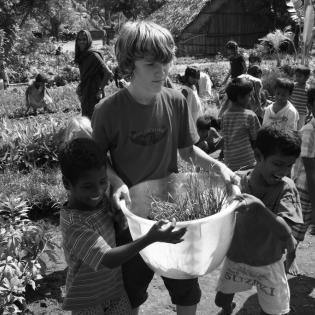To Repair the World: Why? (Private-Religious)
This lesson will familiarize learners with a story of Creation from the Jewish mystical tradition. The story, based upon the Sefer Yetzirah, provides the foundation for the Jewish concept of tikkun olam, repair of the world. Learners will begin to formulate a personal concept of what that message might mean in their own lives.
The learner will:
- define tikun olam.
- retell the story, based upon the Sefer Yetzirah, in which the concept of tikun olam originated.
- formulate a personal application of the concept of tikun olam and implement it in his/her life.
- Attachment One: A Story of Tikun Olam: Humpty Dumpty
- Attachment Two: The Source
- Attachment Three: Why Me?
The learners are encouraged to discuss with their families the assigned Attachment Three: Why Me?(Creation: Your Personal Instruction Manual) for insights and possible input.
- Bayar, Steven Rabbi. To Fix the World – Stick Your Neck Out. Self-published, 1998.
- Kaplan, Aryeh (editor). Sefer Yetzirah: The Book of Creation. Red Wheel/Weiser, York Beach, ME. 1997 (revised). ISBN 0877288550.
Instructions
Anticipatory Set:As the learners enter the room, have boldly written on the display board the words: Tikun Olam. Once they have settled into their seats, begin this lesson by pointing to and telling them that today’s lesson will focus on the concept of tikun olam but that prior to getting into the lesson,you would like them to recite the nursery rhyme- Humpty Dumpty. After listening to what might be a variety of recitations, distribute copy of Attachment One: A Story of Tikun Olam: Humpty Dumpty to each learner. Ask them to think about why you might have started out this lesson in this way. After they share their ideas, be sure that they conclude that the Humpty Dumpty story contains some parallels/comparisons to the traditional ideas about the role of the Jewish people in the world- tikun olam.
Distribute copies of Attachment Two: The Source and instruct the learners to read the story entitled It Happened at the Creation.
Take a few minutes to talk about the story,It Happened at the Creation,and thentell the learners to respond to the questions posed at the bottom of the handout.
Given sufficient time for the learners to respond to the questions, lead a whole group discussion about possible responses to the questions at the bottom of this handout, asking learners to compare and contrast their responses with the responses of their peers.
Teacher Note: The following are important points that should be identified by you or the learners during this whole group discussion.Each story deals with an aspect of humanity’s responsibility for the repairing of the world
In Humpty Dumpty:
responsibility is derived from the authority of the king.
the emphasis is on the men’s inability to complete the task.
humanity’s role is clear, defined and limited.
In It Happened at the Creation:
responsibility is derived from our relationship with G-d.
the emphasis is on the varied and on-going nature of world repair.
humanity’s role is dynamic and unlimited.
It is important that the learners be able to describe the relationship of humanity and G-d portrayed in It Happened at the Creation.
Judaism regards creation as an on-going process with humanity being G-d’s partners in its completion and perfection.
The vehicles for tikun olam are evident in Creation and available for humanity’s discovery and use.
Conclude this lesson by distributing a copy of Attachment Three: Why Me? to each learner. Go over the instructions for this handout and encourage the learners to reflect seriously on this assignment. Challenge them to share their assignment with their families and solicit ideas and input from them to possibly be included in their Creation: Your Personal Instruction Manual portion of the handout and assign due date for this assignment.Teacher Note: Since this activity will be useful for Lesson Three in this Unit, it would be helpful to assign the due date at least by the time you anticipate beginning instruction in Lesson Three.
Learner involvement in class discussions, the evidence of their understanding of tikun olam, and the completion of their homework assignmentAttachment Three: Why Me? (Creation:Your Personal Instruction Manual)
Philanthropy Framework
-
Strand PHIL.I Definitions of Philanthropy
-
Standard DP 01. Define Philanthropy
-
Benchmark MS.4 Give examples of how individuals have helped others.
-
-
Standard DP 06. Role of Family in Philanthropy
-
Benchmark MS.2 Discuss the function of family traditions and role modeling in teaching about sharing and giving.
-
-
-
Strand PHIL.II Philanthropy and Civil Society
-
Standard PCS 01. Self, citizenship, and society
-
Benchmark MS.4 Describe the characteristics of someone who helps others.
-
-
Standard PCS 03. Philanthropy and Economics
-
Benchmark MS.4 Give examples of how civil-society-sector giving can impact communities.
-
Benchmark MS.5 Define <i>stewardship</i> as a trust of common resources held by a community for citizens.
-
-
-
Strand PHIL.III Philanthropy and the Individual
-
Standard PI 01. Reasons for Individual Philanthropy
-
Benchmark MS.3 Identify and give examples of stewardship in cultural traditions around the world.
-
-
